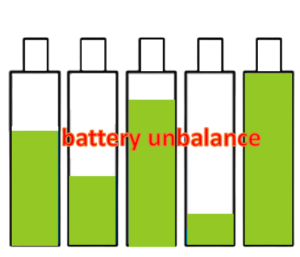Li-ion Battery Pack Balance – What You Need to Know

Recent years, more and more electric products have adopted lithium-ion battery packs as the main power supply. Nevertheless, cell inconsistencies still exist. That is, states of cells in a pack can not absolutely be the same.
When charging and discharging lithium-ion battery packs, we can take balanced measures to ensure safety and stability if we take into account the inconsistencies of each single cell.Battery balancing is a technology that extends battery life by maximizing the capacity of a battery pack with multiple batteries in series, ensuring that all its energy is available for use.
This article mainly analyzes the meaning, main technology and other related questions of balanced processing. Read on and make your own mind up

CONTENT

What is the meaning of lithium ions battery balance?
The battery balance is very important for battery itself and for users.
Let’s focus on
The meaning of battery balance is to keep the voltage of the lithium-ion battery cell or the voltage deviation of the battery pack within the expected range. So as to ensure that each battery cell remains in the same state during normal use, in order to avoid overcharging and over-discharging.
In other words,
Balancing Li-ion battery helps to maximize the capacity and service life of the Li-ion battery.
Battery balancing minimizes and prevents undesirable, and often unsafe conditions. For example, internal gas release, thermal runaway, or other catastrophic failures.
SO, What process can achieve battery balance?
Both Battery Management System(BMS) and charging controller can achieve battery balance.
In this article, we will talk about BMS more. The following are types of technologies of BMS.
Types of Battery Balance Technology
Battery balancing is one of the core functions of a BMS. Here are two mainly types of battery balancing: active balancing and passive balancing. The main difference between them is if they will waste battery energy or not.
Let’s focus on DEEPLY,
Active Balancing= transfers energy from high voltage cell to another cell with low voltage.
APPLY FOR high-series, large-capacity power-type lithium battery pack


Passive Balancing=Through resistance discharge, batteries with higher voltages are discharged to release power in the form of heat, and to buy more charging time for other batteries.
In other words, burns off excess energy from the higher energy cell through a resistive element until the charge matches the lower energy cell.
APPLY FOR low-series, small-capacity lithium battery pack
Preliminary judgment, active balance is better because it does not waste energy.
Disadvantages of active balance and passive balance
1.More components are required than passive equalization, and the cost is higher
2.The reliability is slightly worse and takes up more space.
3.The energy loss caused during the hot standby period may be more energy consumed thanthe equivalent equilibrium.
1.Waste energy and consume costs.
2.High equilibrium current level. Energy is converted into heat and causes loss, which affects the operation of the battery pack.
3.Unable to increase the cell capacity with a small residual amount
Four Forms of Active Balancing
According to energy flow direction, here are four Forms of Active Balancing— you will be more clear about active balance.
Single cell to single cell:
Energy is transmitted between single cells.
Suitable for small-capacity batteries.

Single cell to battery pack:
Energy is transmitted from the single battery with the highest degree of charging to the entire battery pack.
The simplest and most efficient.

Battery pack to single cell:
Energy is transmitted from the entire battery pack to the single battery with the lowest degree of charging.
The performance is best when using multiple single batteries and multiple output chargers.

Bidirectional:
single battery to battery pack or battery pack to single battery can be provided according to demand.
The performance is best when redistributing.

Above, we have know the main technologies about battery balance.
Next, common battery balance methods of both passive and active balance will be introduced.
Resistance Consumption Balance Method-passive balancing method
Through the resistance connected to the battery cell, the energy higher than that of other cells is released to achieve the equilibrium of each cell.
Through connecting resistance and the battery cell, the releasing energy of that battery will be higher. Then battery balance achieves.
1.simple structure
2.Easy to control
3.Fast discharge speed
4.Multiple monomers can be discharged at the same time.
1.High energy consumption
2.The monomer can be discharged but can not be charged
3.Other battery cells must be based on the lowest cell as the standard to achieve balance
4.Low efficiency
Active cell balance circuits are typically based on capacitors, inductors or transformers, and power electronics interface. These entail:
Based on Capacitors–Active Balancing Method
Single capacitor:
Advantage–simple: uses a single capacitor
Disadvantage–requires a large number of switches and intelligent control of the switches
Multiple capacitors
Connect multiple capacitors to each battery in order to transfer unequal energy
Advantage–do not require a voltage sensor or closed-loop control.


Based on Inductors –Active Balancing Method
Single Inductor:
Advantage– small volume, low cost
Multiple Inductors:
Advantage–fast balancing speed, decent cell balancing efficiency
Based on Transformers –Active Balancing Method
Single transformer
Advantage– fast balancing speed with low magnetic losses.
Multiple transformers
Advantage –- fast equalizing speed.
Disadvantage–requires an expensive and complex circuit


Based on Power Electronics Interface–Active Balancing Method
Flyback/ forward converter – the energy of a high voltage cell is stored in the transformer.
Advantage– high reliability.
Full-bridge converter
Advantage– fast balancing speed, high efficiency
Above are simple descriptions of those battery balance methods which are references for your battery design.
Wait a minute,
Before you DIY your battery pack,
You should pay attention to ↓↓↓↓↓↓
Precautions of Battery Balance
When we are separately in the charging and discharging balancing process, we should pay attention to the following issues,
1.Measuring the battery voltage during charging is not accurate. It can cause batterybalancing process Therefore, charging must be stopped periodically in order to measure the battery voltage.
2.Voltage glitches caused by voltage conversion and inductive resonance of the charger will affect battery balance. Because voltage glitches will cause measurement errors.
3.An external power transistor with low on-resistanceis required during charging
1.Unused power will be consumed during the discharging balancing process.
2.Itwill take a long time to balance the battery during discharge. Since resistance determines discharge speed, so the balancing efficiency during discharging is low.
3.If you want a shorter balancing time, you need an external power transistor with a smaller on-resistance
4.A high-power device is required when using a resistor with low resistance.
Q&A
General speaking, cell inconsistencies refer to important parameters of single internal cell parameters are different in the whole battery life span.
That is,
The individual cells in a battery pack have somewhat different capacities, state of charge (SOC) and internal resistance and current of self discharge which will affect battery performance and life length.
Obviously, there is also cell consistency. In ideal condition, SOC of each cell is absolutely the same. That is, every single cell can charge fully and discharge over at the same time.
There are two main aspects:
- Manufacture:
technology, purity of materials, etc.
- Using environment:
In a pack, every cell is placed in different location, thus every cell has different using environment. For example, temperature will be slightly different, cells will be inconsistency with long term accumulation.
Battery balancing technology improves battery life by maximizing the capacity of a battery pack with multiple cells in series, ensuring that all of its energy is available for use.
Yes, of course. Balancing is only necessary for packs that contain more than one cell in series. Parallel cells will naturally balance since they are directly connected to each other, but groups of parallel wired cells, wired in series (parallel-series wiring) must be balanced between cell groups.
Moreover
Battery balance is an important function of BMS. And every lithium ion battery pack has its own BMS. Thus battery balancing is necessary. For other kinds of battery packs, battery balance is a great way to prevent them from overcharging and over-discharging.
In short,
Battery balance aims to solve shortcomings of battery itself. It is necessary for them.
atPrev Article: What to Do If Your Lithium Btery Leaks: What To Do And What Not To Do
Next Article: Damaged Lithium Ion Battery



Thanks for sharing
Love your product